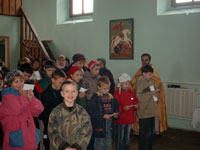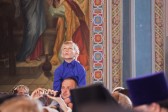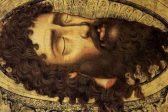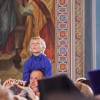 Invisibly, very near us, touching us all, is a real world, of
Invisibly, very near us, touching us all, is a real world, of
divine order and beauty, inhabited by spirits, whose mission it is to bring
order and beauty, where they can, to mortal souls who are struggling for such
things…The greater poetry is a flowing in of light from the source of all light,
from that King, from Whom comes our knowledge of the kingly, in Whose wisdom we
advance, under Whose majesty we move, and in Whose beauty, if we have cared for
beauty, we may come to dwell. His ways are the ways of light, vouchsafed…, that
this world may know a little of the wisdom, beauty and power which are the daily
bread in Paradise.
John Masefield (1878-1967), Poetry, pp. 59-60
There are some so blessed by ancestral and parental piety that, even in early
childhood, they possess a sense of inward beauty, that is the taste of holiness,
and so understand that human destiny is Divine. The greatest example is that of
the Holy Virgin, who at the age of four went to live in the Temple in Jerusalem.
However, we also know of many examples of child saints or saints who, as small
children, entered monasteries and convents and understood liturgical beauty, a
reflection of the inward beauty of the holiness of God.
True, such spiritual sensitivity and intuitiveness are now extremely rare.
Today, the vast majority of children have little sense of
outward beauty, let alone inward beauty.
Nevertheless, all children can be taught a sense of outward beauty. This is most
important in modern society, which exalts the cult of ugliness. Today’s cult of
the ugly is justified by claims that it merely reflects reality. Although it
does indeed reflect the very worst of reality, the extremes of human sinfulness
and lack of repentance, it does not reflect the reality of most. Certainly, it
does not reflect the reality of the higher and nobler in humanity, its spiritual
and religious ideals. Poetry, idealism, elegance, refinement, delicacy and
femininity, today all belong to the unfashionable and mocked category. In
reality, the contemporary cult of ugliness does not reflect reality, but simply
drags down humanity to its own brute level, that of the lowest common
denominator.
Thus, even eighty years ago ‘modern’ art was called ‘the corpse of beauty’ by
the Russian philosopher Sergius Bulgakov. The same term can be used for most
modern music, sculpture, literature, architecture and fashion. The same is also
true of most modern television, music and computer games, with their worship of
foul language, debauchery and violence (1). Today’s standards are set by the
cult of ugliness. The standards set for today’s children are either that of the
alien monsters and demons of an imagined, but possibly real, science fiction
future or else, similarly, the demonic imagery of a real pagan past. For that
pagan past is now resurfacing, whether in interest in Japanese monsters, Chinese
dragons and superstitions (feng-shui), African tribal art and masks, Indian gods
and buddhas, Germanic mythology, Celtic spiritism (Hallowe’en), Egyptian corpses
and sphinxes, or cruel Greek and Roman fables.
What models of outward beauty can parents then provide for their children
today, as alternatives and antidotes to the contemporary cult of ugliness?
Firstly, children can be taught very easily of natural
beauty, the beauty of the infinite variety of the natural world. For
example, even fathers and mothers who live in flats in big cities without
gardens, can take their children to parks and show them flowers and butterflies,
spring blossoms and autumn leaves, pointing to the beauty of the clouds and the
stars, sunrise and sunset. Others may be able to take their children to the
country, to national parks, to the sea and the ocean and show them the beauty of
hill and lakes, woods and fields.
Here, it is important not to fall into the trap of nature-worship, a trap
which in fact is idolatrous, the worship of natural beauty for its own sake.
This trap, which forgets that nature is now in a fallen state, can lead to pagan
environmentalism and all its rites.
Secondly, children can be taught of manmade beauty, the
beauty of the arts, of music, literature, painting, sculpture,
architecture and other forms of human creativity, which in Greek is ‘poetry’.
For example, fathers and mothers can take their children to exhibitions,
galleries, museums, concerts or to different towns. If this is not possible,
then they can simply give their children beautiful images and pictures, which
they can cut up and put into scrapbooks.
Here, it is important not to fall into the trap of aestheticism, a trap which
in fact is idolatrous, the worship of manmade beauty for its own sake. This
trap, which forgets that all human creativity is imperfect, can lead to elitist
snobbery, narcissistic vanity and priggish pride.
Thirdly, children can be taught of moral beauty, the beauty
of moral human relations. For example, the mutual love of father and mother for
one another and their children can provide a lifetime example of self-sacrifice
for them. If this is not given, as so often in today’s world of no effort at
self-improvement and renunciation for the other, and so separation and divorce,
children can grow up in moral distress and easily become psychologically
unbalanced.
Here, it is important not to fall into the trap of ancestor-worship, a trap
which is in fact idolatrous, the worship of our forebears for their own sakes.
This trap, which forgets that our parents are merely part of creation and not
creators themselves, can lead to the exclusion of the Divine.
Finally, through such a hierarchy, proceeding from natural
beauty to manmade beauty and on to moral
beauty, children may not only be able to appreciate something of
outward beauty, but also to learn of inward or
spiritual beauty, which, beyond the outward, is a much higher beauty.
For, although outward beauty exists in this world, it is but a reflection of
much higher, inward beauty, the spiritual beauty of holiness, the beauty of God.
For every beauty in this world, however fine, is but the image and shadow of
ultimate beauty, the beauty of the Divine Prototype and Creator. As the poet
wrote:
If God hath made this world so fair,
Where sin and death
abound,
How beautiful, beyond compare,
Will paradise be found.
James Montgomery (1771-1854), The Earth is Full of God’s
Goodness
Note:
1. Compare today’s films with:
‘Obscenity in word, gesture, reference, song, joke, or by suggestion, is
forbidden… Scenes of passion should not be introduced when not essential to
the plot. In general. passion should be so treated that these scenes do not
stimulate the lower and baser element…No film may throw ridicule on any
religious faith. Ministers of religion, in their character as such, should not
be used as comic characters or as villains. Ceremonies of any definite religion
should be carefully and respectfully handled’.
From the code of ethics adopted by the Motion Picture Producers and
Distributors of America on 31 March 1930.
http://www.orthodoxengland.org.uk















